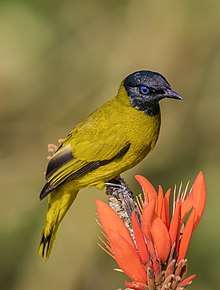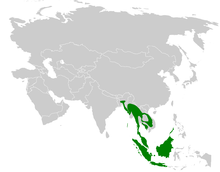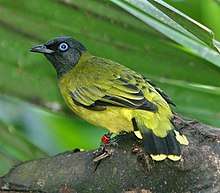Black-headed bulbul
The black-headed bulbul (Brachypodius melanocephalos) is a member of the bulbul family, Pycnonotidae.[2] It is found in forests in south-eastern Asia.[1]
| Black-headed bulbul | |
|---|---|
 | |
| Scientific classification | |
| Kingdom: | Animalia |
| Phylum: | Chordata |
| Class: | Aves |
| Order: | Passeriformes |
| Family: | Pycnonotidae |
| Genus: | Brachypodius |
| Species: | B. melanocephalos |
| Binomial name | |
| Brachypodius melanocephalos (Temminck, 1822) | |
 | |
| Synonyms | |
| |
Taxonomy and systematics
The black-headed bulbul was originally described in the genus Turdus. It was later moved to the large bulbul genus Pycnonotus as Pycnonotus atriceps. Pycnonotus was found to be polyphyletic in recent molecular phylogeny studies and the species transferred to Brachypodius with the species epithet melanocephalos, which has priority over atriceps..[2][3]
Until 2008, the Andaman bulbul was considered as a subspecies of the black-headed bulbul.[4]
Subspecies
Four subspecies are recognized:[2]
- B. m. melanocephalos (Gmelin, 1788) (synonym B. m. atriceps (Temminck, 1822)): found in north-eastern India and Bangladesh though Southeast Asia to the Greater Sunda Islands and western Philippines
- B. m. hyperemnus (Oberholser, 1912)f: Found on western Sumatran islands
- B. m. baweanus Finsch, 1901: originally described as a separate species. Found on Bawean (north of Java)
- B. m. hodiernus (Bangs & Peters, JL, 1927): originally described as a separate species. Found on Maratua Island (off eastern Borneo)
Description

The black-headed bulbul has a mainly olive-yellow plumage with a glossy bluish-black head. A grey morph where most of the olive-yellow is replaced by grey also exists. It resembles the black-crested bulbul, but has blue eyes (though not reliable in juveniles), a broad yellow tip to the tail, and never shows a crest (however, some subspecies of the black-crested are also essentially crestless, but they have red or yellow throats).
Behavior and ecology
The black-headed bulbul mainly feeds on small fruit and berries, but will also take insects. It commonly occurs in small flocks, comprising 6-8 individuals.
References
- BirdLife International. (2016). "Brachypodius atriceps". IUCN Red List of Threatened Species. 2016: e.T103836079A94339713. doi:10.2305/IUCN.UK.2016-3.RLTS.T103836079A94339713.en. Retrieved 4 August 2020.
- Gill, F.; Donsker, D.; Rasmussen, P. (eds.). "Family Pycnonotidae". IOC World Bird List. Version 10.2. International Ornithological Congress. Retrieved 4 August 2020.
- Shakya, Subir B.; Sheldon, Frederick H. (2017). "The phylogeny of the world's bulbuls (Pycnonotidae) inferred using a supermatrix approach". Ibis. 159 (3): 498–509. doi:10.1111/ibi.12464. ISSN 0019-1019.
- "Species Version 1 « IOC World Bird List". www.worldbirdnames.org. Retrieved 10 March 2017.
